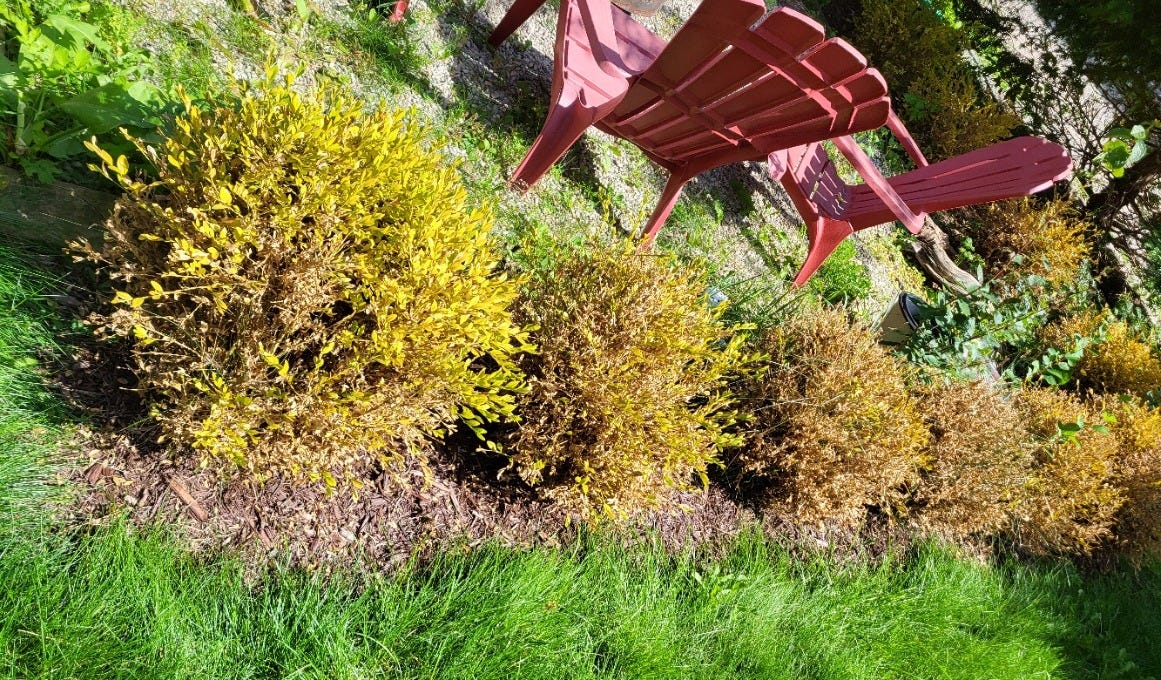Bye Bye, Boxwood: Local Gardeners Grapple With Blight and Invasive Moths
Boxwoods are dying across Southern Ontario. Jennifer Deeks looks at the pests behind the decline and suggests alternatives for local gardens.
COMMUNITY CONTRIBUTION
Each year brings new pests and diseases to our gardens. Last year, our area lost so many beautiful mature magnolias to scale insects. This year, boxwoods that were once problem-free evergreens are being decimated across Southern Ontario.
A drive through Owen Sound reveals brown, crispy, boxwood shrubs in all parts of the city. Gardens that I visit every several weeks can have lush green boxwood one visit, and completely dead ones the next. I’ve spent a lot of time explaining to clients that I don’t recommend planting new boxwood and that I am not optimistic about saving theirs.
Boxwood (Buxus spp.) are an evergreen shrub native to Western Europe. They are most recognizable for their formal topiary designs seen on British estates, where they form dense hedges and topiaries.
While we are less likely to be designing mazes to meander through in our fancy dress, they perform a similar function in many gardens in our region. They can be clipped into tidy shapes and often serve as a structured anchor to support less formal plantings.
Boxwoods are under two main threats:
the box tree moth (Cydalima perspectalis)
and a fungal infection called boxwood blight (Calonectria pseudonaviculata).
The first may be survivable; the second has a more grim outlook. I find the box tree moth to be sneaky. You know that they are there because of the skeletonized leaves, webs, and frass (poop!).
But the caterpillars themselves, with their yellow, green, and black colouration, are master camouflage artists. At an inch in length, they are not small, but even when I know that they are there, they are still hard to locate.
Pyrethrins — a reasonably low toxicity pesticide derived from chrysanthemums — work well as long as you can get direct contact. This product does come with collateral damage, as it harms spiders and other beneficial insects. Bacillus thuringiensis (Bt) is a type of bacterial pesticide that works best early in an infestation because the caterpillars need to ingest it.
Blight moves fast and furious. It is a fungal infection, and within a couple of weeks, boxwoods turn brown and drop all their leaves.
Blight can survive in the environment for up to 5 years, preventing new plantings and affecting new growth. The biggest problem is that there is simply no treatment. Preventing spread by disinfecting tools, applying preventive fungicides, and removing affected plants is the only option.
If you simply must have boxwood, there are several cultivars that are more blight-resistant, including ‘Green Mountain’. If you would like a native option, the common snowberry Symphoricarpos var. albus can be a bit of a spreader, but it does tolerate tight pruning.
To maintain an evergreen appearance, both yew and holly can be considered. In small spaces, I prefer globe cedars like ‘Tater Tot’ for their similar round appearance.
The future of boxwoods in Ontario is not bright. It’s a stark reminder that a heavy reliance on a particular species can quickly become problematic and also that when we introduce a host species, the pests and diseases that affect it are bound to follow sooner or later.
Thank you to sponsors of The Owen Sound Current Writers’ Fund, who make these community contributions possible. Contributions from the community do not necessarily reflect the opinions or beliefs of The Owen Sound Current and its editor or publisher.





